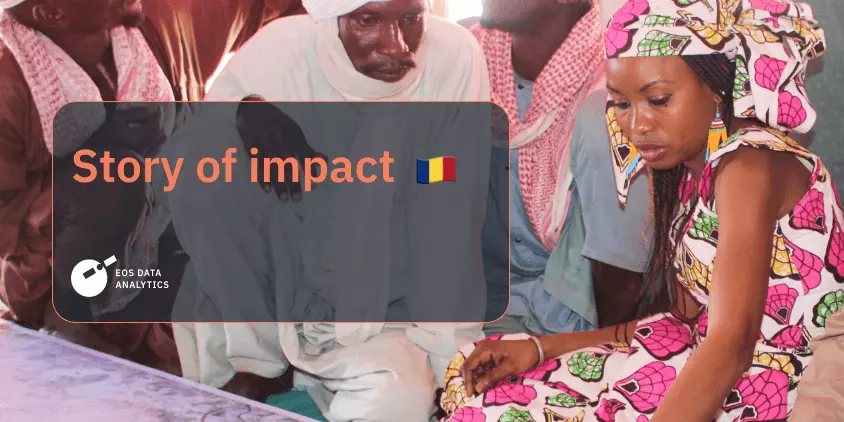
EOSDA Space Tech Meets Barefoot Mappers In Chad
Communities in developing countries, like Chad, who rely on pastoralism and subsistence farming to provide for themselves and their families, are especially at risk of extreme weather events driven by climate change. Why are these people vulnerable? Weather extremes lead to the shortage of natural resources or deterioration of their quality. For a population whose food security and overall well-being depend on access to natural resources, climate change is not just an abstract term — it means everyday challenges.
Regular people can hardly influence Chadian decision makers who, ideally, are responsible for monitoring environmental impact from enterprises’ activities and improving the standard of living, but who fail to do so. What communities can do is evaluate how they use remaining resources and find ways to ensure resource availability for future generations.
This social case study is about one of the examples of cooperation between communities striving to adapt to the consequences of climate change — scarce fertile land and freshwater.
EOS Data Analytics, a global provider of satellite imagery analytics, contributed to the participatory mapping project organized by Hindou Oumarou Ibrahim, a member of the Mbororo pastoralist people and founder and president of the Association for Indigenous Women and Peoples of Chad (AFPAT).
The project aims to mitigate the conflict over limited natural resources between local and indigenous communities and help indigenous peoples adapt to climate change.
The company obtained a satellite image of the area of interest with EOSDA LandViewer, a digital satellite-driven tool by EOSDA, and created a printable map layout with annotated natural and artificial objects to make it ready for mapping by locals.
But before we dive into the project details, let’s overview the factors behind the dwindling natural resources in the country.
What Went Wrong With Chad’s Climate?
As for 2019, Chad was the last (the 182nd place) in the ranking according to the Notre Dame Global Adaptation Initiative index . The index represents a country’s vulnerability to climate disruptions and other global challenges in combination with its preparedness to improve resilience.
One of the challenges is the rise in temperatures, with mean annual temperatures in Chad having increased by 0.7°C since 1960 . Temperatures in northern, western, and eastern provinces are predicted to be increasing 1.5 times higher compared to the global average.
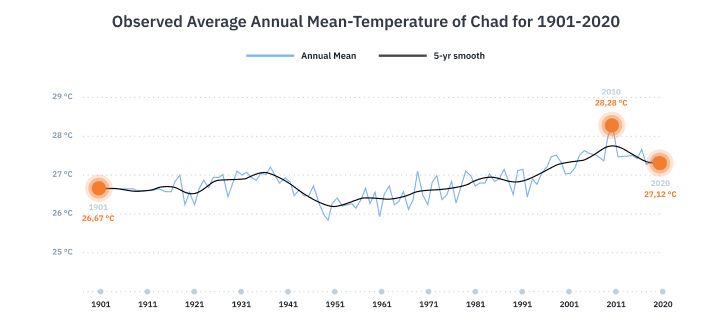
Rising temperatures disrupt the state of flora and fauna and weather patterns, particularly the rainfall patterns. Chadians have been suffering from more and more weather extremes, droughts and floods, for decades. In 2021 alone, more than 250,000 people (over 42,000 households) were affected by the floods sweeping across the country , resulting in the loss of livestock, damage to cultivated land and crops, and destruction of houses.
The country has also been scourged by droughts causing substantial land degradation: loss of soil fertility, lower productivity, and decrease in biodiversity.
In both scenarios, people practicing rainfed agriculture and subsistence farming are left with decreasing resources to maintain their livelihoods. A housing crisis due to damage caused by floods combined with famine and related anxieties can provoke outbreaks of violence and conflicts.
Conflicts Over Shrinking Natural Resources: Is There A Solution?
The disruption in peoples’ lifestyles due to climate change has already given rise to a conflict that has been lasting for 15–20 years in the country’s Mayo-Kebbi Est region. The reason was that the nomadic pastoralists from indigenous communities and local farmers couldn’t agree on the fair use of land and freshwater points.
Land and water are essential for both communities, and climate change has created a number of issues to drive human aggression.
Land. Shorter and more irregular rainy seasons have caused droughts, forcing farmers and pastoralists to change their traditional land-use patterns. Farmers need more land to get sufficient yields of food crops, while nomadic herders are searching for new pastures. Transhumance corridors — strips of land used for cattle to get from pasture to pasture — may run through cultivated lands. Farmers may also establish their plots next to cattle corridors leaving no space for livestock to pass through to grazing land.
Water. Lack of rainfall also leads to water points drying up, which is why pastoralists are forced to look for additional sources of water (rivers or lakes) near or in the villages. Where there is a village, there is agricultural land. Government and military representatives grab and privatize land, blocking access to it for nomadic pastoralists and those farmers who solely rely on rainfall for irrigation. In some cases, the herders’ cattle would damage crops on the land open for use right before harvesting.
Fortunately, there are ways to reduce this and similar disputes by initiating dialog between the conflicting sides on how to coexist amid resource scarcity and adjust to a changing environment. Precise satellite mapping of large areas with scarce land and water resources is one of the solutions. EOS Data Analytics has recently provided Hindou Oumarou Ibrahim, founder, and president of AFPAT, with a map for a participatory mapping exercise.
Participatory Mapping Project: When Technical Expertise Meets Indigenous Knowledge
Leaders of 116 communities from 23 villages met to agree on the sustainable use of limited natural resources within the participatory mapping project.
Participatory mapping entails creation of maps by local communities for their needs. Such initiatives mainly take place with assistance from NGOs, tech companies, educational institutions, or other parties engaged in management. Participatory maps often represent a given territory from its residents’ perspective: people focus on natural physical and essential socio-cultural features.
The initiative aims at establishing peaceful and sustainable management of shared resources. It might help indigenous peoples become less vulnerable to climate change while maintaining their traditional lifestyle.
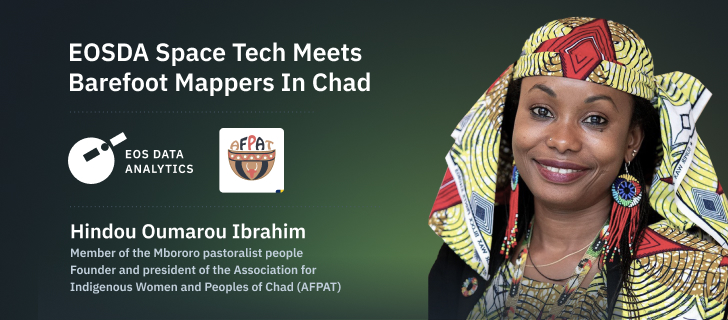
The project’s objective is to mitigate the ongoing conflict over shared resources between the communities. How? By combining the traditional spatial knowledge of indigenous people and scientific knowledge to create a sustainable resource management strategy and that way to adapt to climate change.
Indigenous peoples’ knowledge stems from nature observation. For example, one can predict rain by observing the behavior of insects or looking at the sky. A person may also know where specific medicinal plants grow or which fruits or leaves are edible, and so on.
The technical expertise was represented by geospatial data specialists of EOS Data Analytics and beyond, and Giacomo Rambaldi, an international consultant in participatory mapping.
During the process of mapping, community members can identify disputed areas and shared water points, negotiate rules of their use, and find a compromise: for instance, to plan crop growth during the season, open or close cattle corridors, coordinate when and where to lead cattle on farmlands to fertilize them and bring cattle to water points.
Project Implementation
The 2D map, based on a satellite image, covers 1728 square kilometers of territory.
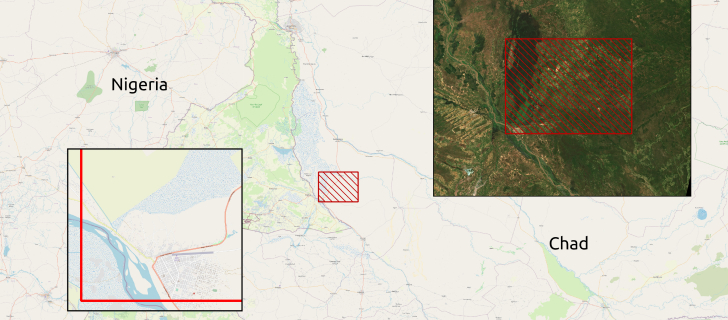
The map creation consists of several stages. Here’s a short overview of all the stages.
1. Consultations With Indigenous Communities And Scope Of Work Formulation
The project starts with a preliminary stage. Its goal is to involve community chiefs to discuss scarce resources and land management issues fueling the conflict and define the area of interest. Hindou Oumarou Ibrahim started hosting meetings and workshops in 2019, and in November 2021, the communities agreed on the territory the map must cover. Giacomo Rambaldi transformed the scope of work into requirements for EOS Data Analytics.
2. Cartographic Material Preparation By EOS Data Analytics
This stage entails preparing a 2.8 m x 2.3 m map layout and consists of two steps.
- Obtaining a satellite image. The satellite image was obtained using EOSDA LandViewer, a live satellite observation imagery tool that allows searching, processing, and getting valuable insights from satellite data. The Sentinel-2 satellite imagery at a resolution of 10 m was used for this purpose, which means that 1 pixel represents an area of 10 m x 10 m (100 m2) on the ground. Consequently, the scale of the future map is 1×10,000: 1 cm in the map equals 10,000 cm (100 m) of the territory.
- Preparing a map layout in QGIS. The image was then edited in QGIS — software for viewing, managing, and analyzing spatial data and composing maps. The editing entails map annotation — creating a vector image layer with objects of various types and adding it on top of the satellite image.
The elements include lands with high and low vegetation density, croplands, wetlands, the Chari River, and artificial objects — settlements and roads.
It’s essential to ensure objects are added with accuracy. Otherwise, a map will be useless.
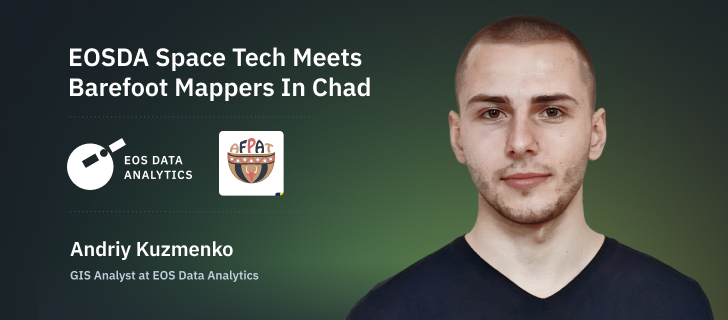
To be precise, one must consider the brightness and spectral characteristics of objects. For instance, different levels of vegetation can be classified based on the values of vegetation indices (Normalized Difference Vegetation Index, leaf area index, and other types of spectral indices).
A satellite sensor can capture reflected sunlight (energy) in fixed ranges of the electromagnetic spectrum. Light travels in the form of waves. And since a plant absorbs and reflects specific wavelengths based on its current condition, it’s possible to evaluate its biomass and vigor.
Spectral indices are also used for detecting water objects. Additionally, one can use open data sources such as OpenStreetMap to identify objects on the surface and add them to the map. While working with the RGB image, we relied on brightness and contrast parameters, which allowed us to choose similar groups of objects for further map annotation.
Once all objects were added, the map was exported in PDF format to be ready for printing and participatory mapping.
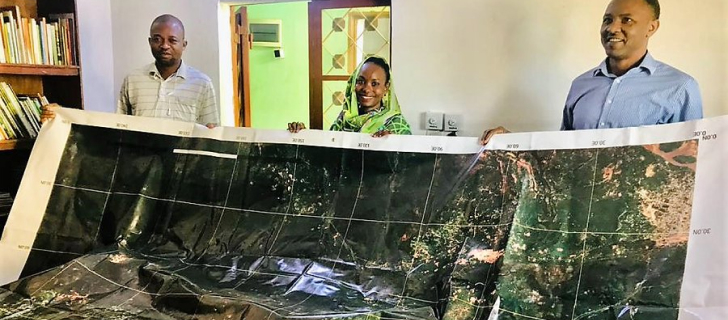
3. Map Annotation By Indigenous Peoples And Local Communities
That’s the stage where the participatory mapping takes place. Members of indigenous and local communities have been gathering at the Gournoida village to annotate the map based on an agreed legend. The map legend is a set of features (objects on the ground) represented by graphic symbols.
Natural and human-made map objects include:
- Schools
- Villages
- Churches
- Markets
- Châteaus
- Hospitals
- Graveyards
- Water pumps/towers
- Swamp areas
- Ponds (artificial, small, big)
- Cattle arks
- Cattle corridors
- Plants, etc.
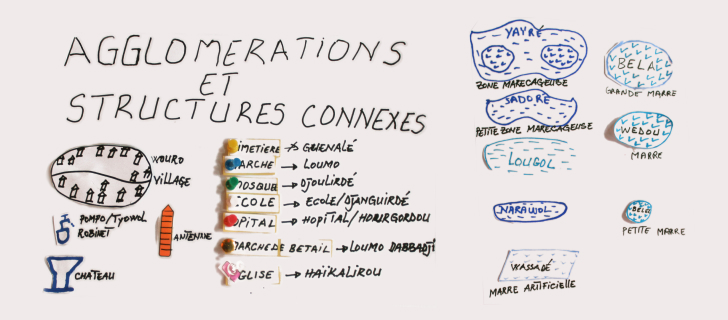
The participatory mapping exercise lasted two weeks and also included two main rounds. Men took part in the first round and documented such objects as water points, villages, or tree types.
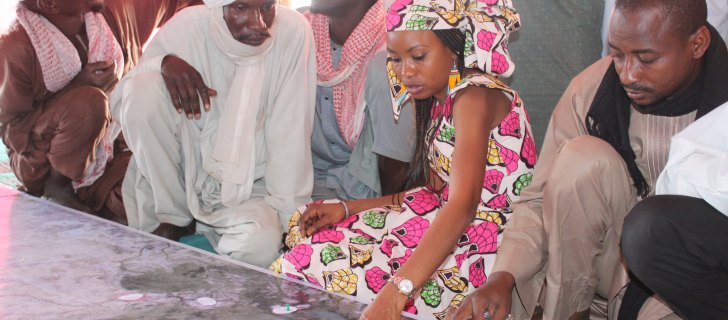
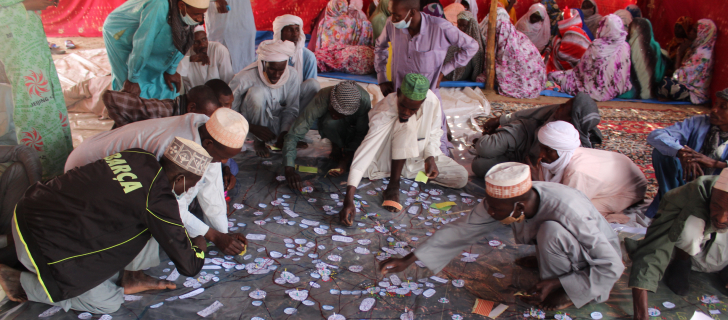
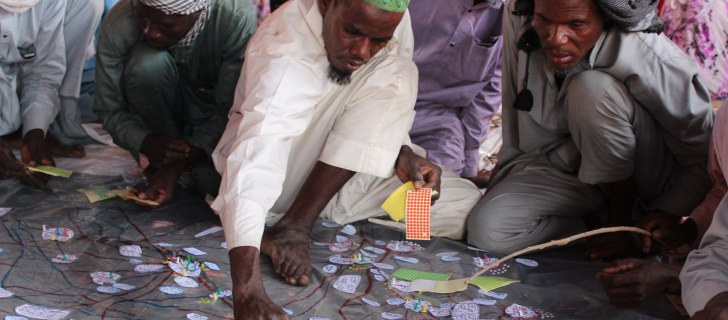
The map from a woman’s perspective. Then, women reviewed the annotation and added new objects to the map. Since the Mbororo women are in charge of household chores (e.g., fetching water, milking and making milk products, cooking) and raising kids, they updated the map based on their responsibilities. Hindou also emphasizes women’s seasonal knowledge about weather and flora and fauna linked with land use:
Women know better than men what is going on in each place or territory during the rainy and dry seasons.
So, local women mapped the areas where certain vegetables grow during the rainy season, spots with edible, medicinal, and sacred plants, springs, food storages, schools, etc.
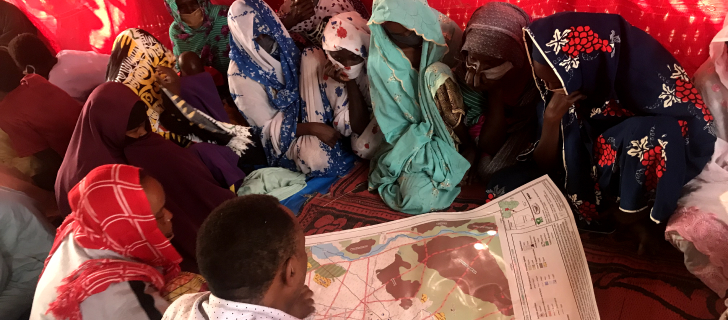
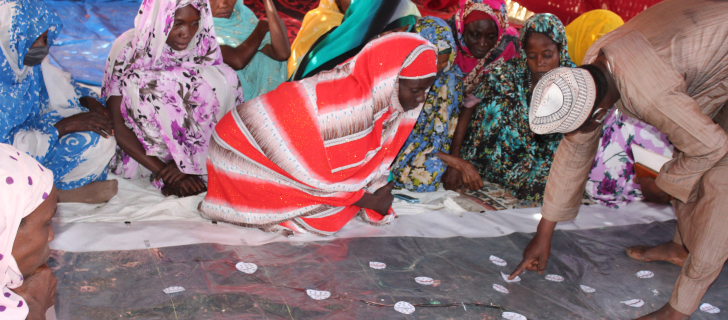
By inviting women to contribute to the project, Hindou strives to gradually change the traditional perception of women who, particularly, have limited decision-making powers in the family- and community-wide matters.
The project allowed for making women’s voices heard, turning them from observers into decision-makers. So for me, it’s the exercise that empowers women and helps men realize that their wives, mothers, or daughters also have a word to say and are very knowledgeable.
4. Map Finalization And Digital Version Creation
The goal of this stage is to combine and verify mapping results and create a digital version of the map for further dissemination of copies among communities.
But before the map is digitized, one must check whether mapping results are acceptable to the community. Three workgroups, each responsible for checking given map objects (e.g., cattle corridors, water sources, churches, mosques, markets), evaluated annotations. Participants inspected territories with GPS apps to ensure coordinates of objects were correct and specified object types (e.g., types of plants or crops) if it hadn’t been done before.
By the end of December 2021, the map was finalized and presented to the communities and local authorities.
After all these steps had been completed, a series of high-resolution photos of the annotated map was taken for processing with GIS software. The specialists digitized the map by the end of February 2022.
Mitigating A Conflict Via Cooperation And Self-organization
The 2D map will supplement the written agreement for the community representatives on using natural resources and possible ways of resolving conflicts in the long term. Later in 2022, Hindou plans to host the convention with community chiefs to discuss the agreement terms and sign it.
And people from Hindou’s native places are looking forward to this meeting and getting the chance to see the results of their joint work.
They are calling me even in Paris. One community chief recently called me asking when I am coming back.
It’s worth noting that communities have been supporting the project with great enthusiasm. Initially, only 24 communities had to participate in the mapping, and in the end, members of 116 communities joined the initiative. And the map that now covers 1728 square kilometers was supposed to represent not more than 40–60 km.
Hindou also notes a high level of self-organization among everyone involved. Locals even decided to construct a building in Gournouda for storing a physical map.
Giacomo Rambaldi emphasizes the human impact of the initiative. The mapping exercise gives those involved a bird’s-eye view of their surroundings and, in many cases, an understanding of the root causes behind environmental or social problems they face.
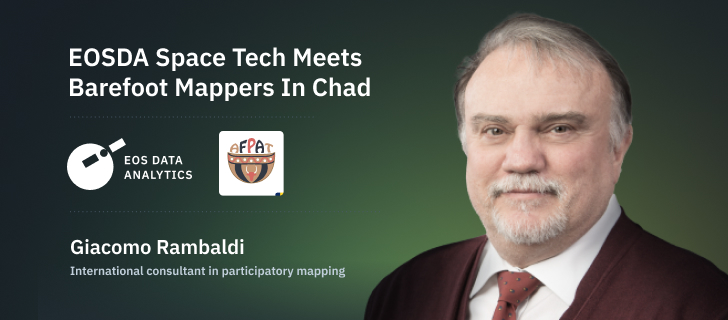
In participatory mapping, the process is often even more important than the outcome. The work on the map or a 3D model sparks discussion and negotiation. People begin to realize the sources of their problems. So, the exercise isn’t just about painting and drawing lines. There is much more behind the participatory mapping.
I realized that the project means a lot for many people on another continent who struggle there and now. That’s what was driving me while I was working on the assignment. Our company’s mission and vision are to put satellite technologies, ML algorithms, and data to use so that customers worldwide can solve their daily problems. I think we managed to deliver services according to the said mission and vision, and I’m glad to be a part of this project.
Hindou Oumarou Ibrahim and colleagues didn’t plan to stop once the map was ready. The next project is the map for communities living North-South of the shrinking Lake Chad.
The EOSDA team has recently provided a satellite image-based map, which Hindou printed for the participatory mapping exercise. So, stay tuned: We’ll tell you more about this initiative soon.
About the author:
Vera Petryk is in charge of marketing and PR for EOSDA with a focus on promoting sustainability and preserving the Planet by bringing space technologies closer to Earth. She has a degree in marketing from the Netherlands Institute of Marketing as well as a master’s degree from Kyiv Institute for Interpreters and Translators under the Ukrainian Science and Research center.
Recent articles

Analyze 2025 & Plan Your Best Year Yet: LandViewer Christmas Offer
It’s the most wonderful time of the year! The Christmas holidays are here, and so is your chance to analyze 2025 and plan a prosperous 2026 with more affordable Pro plans in LandViewer.

EOSDA Models Climate Change Impact On Sugarcane Yields
EOSDA modeled future temperature, rainfall, and other climate impacts on Veracruz sugarcane. The results help growers plan long-term adaptation strategies, including timing, varieties, and irrigation.

EOSDA LandViewer Black Friday Sale: Exclusive Offers & Giveaway
This Black Friday, LandViewer offers new users the chance to save on monthly plans, get extra months with yearly subscriptions, and participate in a free annual plan giveaway.